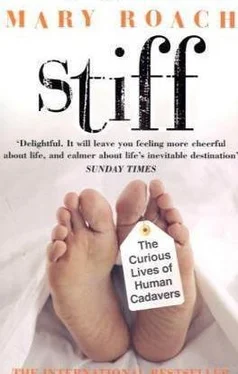DeMaio’s cadaver tests represent a distinct improvement over how vests were originally tested by the military: In Operation Boar, during the Korean War, the Doron vest was tested simply by giving it to six thousand soldiers and seeing how they fared compared to soldiers wearing standard vests. Roane says he once watched a video made by a Central American police department that tested their vests by having officers put them on and then shooting at them.
The trick to designing body armor is to make it thick and unyielding enough to stop bullets without making it so heavy and hot and uncomfortable that officers won’t wear it. What you don’t want is what the Gilbertese Islanders used to have. While I was in D.C. to see DeMaio, I stopped at the Smithsonian’s Museum of Natural History, where I saw a display of body armor from the Gilbert Islands. Battles in Micronesia were so pitched and bloody that Gilbertese warriors would outfit themselves head to foot with doormat-thick armor fashioned from the twisted fibers of coconut hulls. On top of the significant humiliation of making one’s entrance onto the battlefield looking like an enormous macrame planter was the fact that the armor was so bulky it required the assistance of several squires to help maneuver you.
As with automotive cadavers, DeMaio’s body-armor bodies were instrumented with accelerometers and load cells, in this case on the sternum, to record the impact forces and give researchers a detailed medical rendering of what was happening to the chest inside the armor.
With some of the nastier-caliber weapons, the cadavers sustained lung lacerations and rib fractures, but nothing that translated into an injury that—if you weren’t already a cadaver—could kill you. More tests are planned, with the goal of making a test dummy along the lines of those used by the automotive industry—so that one day cadavers won’t be needed.
Because she had proposed to use human cadavers, DeMaio was advised to proceed with extreme caution. She gathered the blessings of three institutional review boards, a military legal counsel, and a card-carrying ethicist. The project was ultimately approved, with one stipulation: no penetration. The bullets had to stop short of the cadavers’ skin.
Did DeMaio roll her eyes in exasperation? She says not. “When I was in medical school I used to think, ‘Come on, don’t be irrational. They’ve expired, they’ve donated their bodies, you know?’ When I got into this project I realized that we are part of the public trust, and even if it doesn’t make scientific sense, we have to be responsive to people’s emotional concerns.”
On an institutional level, the caution comes from fear of liability and of unpleasant media reports and withdrawal of funding. I spoke with Colonel John Baker, the legal counsel from one of the institutions that sponsored DeMaio’s research. The head of this institution preferred that I refrain from naming it and instead refer to it as simply “a federal institution in Washington.” He told me that over the past twenty-some years, democratic congressmen and budget-minded legislators have tried to close the place down, as have Jimmy Carter, Bill Clinton, and People for the Ethical Treatment of Animals. I got the feeling that my request for an interview had brought this man’s day crashing down like so many pine trees behind a DOE shooting range.
“The concern is that some survivor will be so taken aback that they’ll bring suit,” said Colonel Baker from his desk at a federal institution in Washington. “And there is no body of law in this area, nothing you can look to other than good judgment.” He pointed out that although cadavers don’t have rights, their family members do. “I could imagine some sort of lawsuit that is based upon emotional distress….You get some of those [cases] in a cemetery situation, where the proprietor has allowed the coffins to rot away and the corpses pop up.” I replied that as long as you have informed consent—a signed agreement from the donor stating that he has willed his body to medical research—it would seem that the survivors wouldn’t have much of a case.
The sticking point is the word “informed.” It’s fair to say that when people donate remains, either their own or those of a family member, they usually don’t care to know the grisly details of what might be done with them. And that if you did tell them the details, they might change their minds and withdraw consent. Then again, if you’re planning to shoot guns at them, it might be good to run that up the flagpole and get the a-okay. “Part of respecting persons is telling them the information that they might have an emotional response to,” says Edmund Howe, editor of the Journal of Clinical Ethics , who reviewed Marlene DeMaio’s research proposal. “Though one could go the other way and spare them that response and therefore ethically not commit that harm. But the downside to withholding information that might be significant to them is that it would violate their dignity to an extent.” Howe suggests a third possibility, that of letting the families make the choice: Would they prefer to hear the specifics of what is being done with the donated body—specifics that may be upsetting—or would they prefer not to know?
It’s a delicate balance that, in the end, comes down to wording. Observes Baker, “You don’t really want to be telling some-body, ‘Well, what we’ll be doing is dissecting their eyeballs. We take them out and put them on a table and then we dissect them into finer and finer parts and then once we’re finished we scrape all that stuff up and put it into a biohazard bag and try to keep it together so we can return whatever’s left to you.’ That sounds horrible.” On the other hand, “medical research” is a tad vague.
“Instead, you say, ‘One of our principal concerns here at the university is ophthalmology. So we do a lot here with ophthalmological materials.’” If someone cares to think it through, it isn’t hard to come to the conclusion that someone in a lab coat will, at the very least, be cutting your eyeball out of your head. But most people don’t care to think it through. They focus on the end, rather than the means: Someone’s vision may one day be saved.
Ballistics studies are especially problematic. How do you decide it’s okay to cut off someone’s grandfather’s head and shoot it in the face? Even when the reason you are doing that is to gather data to ensure that innocent civilians who are hit in the face with nonlethal bullets won’t suffer disfiguring fractures? Moreover, how do you bring yourself to carry out the cutting off and shooting of someone’s grandfather’s head?
I posed these questions to Cindy Bir, who brought herself to do exactly that, and whom I met while I was at Wayne State. Bir is accustomed to firing projectiles at the dead. In 1993, the National Institute of Justice (NIJ) commissioned her to document the impact effects of various nonlethal munitions: plastic bullets, rubber ones, beanbags, the lot. Police began using nonlethal bullets in the late 1980s, in situations where they need to subdue civilians—mostly rioters and violent psychotics—without putting their lives in danger. In nine instances since that time, “nonlethal” bullets have proved lethal, prompting the NIJ to have Bir look into what was going on with these different bullets, with the aim of its not going on ever again.
As to the question “How do you bring yourself to cut off someone’s grandfather’s head?” Bir replied, “Thankfully, Ruhan does that for us.”
(The very same Ruhan who preps the cadavers for automotive impacts.) She added that the nonlethal munitions were not shot from guns but fired from air cannons, because doing so is both more precise and less disturbing. “Still,” concedes Bir. “I was glad when that one finished up.”
Читать дальше












